The
Villarreal Home Page
by
Danny
Villarreal
WEBJEFE

!!!!!!Discover the
world of our past!!!!!!
This page is for all who share
this surname and our proud heritage. If your not a Villarreal check
it out anyway you might learn something.
The Villarreal surname is a Noble and very old surname its lineage is very well extended throughout the entire Iberian Peninsula. There are several different casas solares in Aragon, Castilla, Pais Vasco y La Rioja. There were only a handful of Villarreal families that entered the New World during and after the conquest. There is also a large concentration of this surname in Argentina. This web page is an attempt to document all of these men and women so that all with this surname can have a starting or ending point for your ancestral search. Y-DNA testing has helped us determine which family group we belong to. The most dominat family group is the Northern Mexico and Southwestern USA family. This area has the largest surname population even larger than Spain. This groups common ancestor is Diego de Villarreal. This family may be related to the Villarreal family from Mexico City, Guadalajara, Zacatecas, Saltilo, Durango and Monterrey, Mexico. Only DNA testing of people from Mexico will verify this.


Villarreal family Coat of Arms
There were many Casas de Villarreal, all over Spain. The oldest known is Joan de Arieiseta from Regil Guipuzcoa, Spain Villarreal who left Regil, Guipuzcoa, after his marriage in 1438 and established a home in Villarreal de Alava . It was after this towns name that his desendants took the surname Villarreal de Areiceta. Some members family settled in the Zacatecas, Guadalajara and Mexico City. We do not know if the Northern Mexico Family from Saltillo , Monterrey and Durango are from this family. |
Genealogy of the Family / Genologia de la familia Villarreal
CLICK ON TREE NEXT TO THE NAME TO GO TO INDIVIDUAL WEB FAMILY CARDS
Our Journey to the New World
History
Links
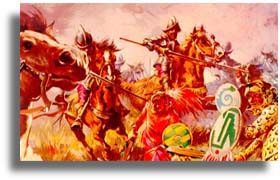

Click below to Navigate through Links:
After you have been to an area
click arrows to return back to these
tables.
Heraldry Sites
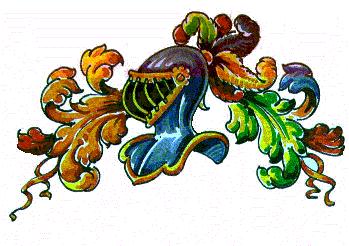
Hispanic Family Genealogy
Sites

Genealogy friends and
Villarreal Links
E-Mail Me


Daniel5822@aol.com
You are visitor number



Jewish Origins ?
Oral History tells stories of
Jewish Origins for some Villarreal families in Spain but for our Mexico family there is no actual proof. DNA
testing of Villarreal
family members show East African roots. Most recent indications are that genetically we may be from the Berber people or North Africa. Many people have
different stories. What have you heard does your oral history reflect Jewish roots.
Lets find out, if you know Id like to include it in this web page.

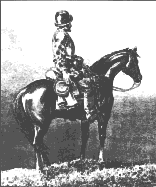
1512
THE ARRIVAL
OF THE VILLARREALES
TO THE NEW
WORLD
THEIR CHARACTER AND
ACCOMPLISHMENTS
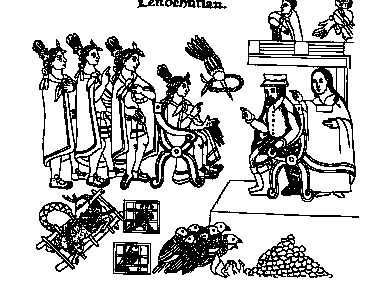
Meeting of Cortez and Moctezuma
THEY CAME AS WARRIORS AND
SETTLERS
During the period in which they arrived into
the new World the Spanish had just finished the Crusades and the
Moors had been driven out of Spain now it was the Jews whom were
given the option of converting or leaving. Spain had just been united
by the marriage of Isabel of Castille and Ferdinand of Aragon. Spain
was not at war within its boundaries and the time for exploration was
ripe. A class of people emerged that for hundreds of years had earned
its respect from the crown by proving themselves in many battles and
now that the wars were over the Crown sought out new lands for these
loyal subjects to be rewarded with. They had earned the title
Hijosdalgo, and along with that they were given all the opportunities
that came with that title. They were the Nobelmen of the New World.
Because they were the first Conquistadores and Pobladores of the new
world their ancestors would share in the rewards of Land Grants and
many other opportunities awarded to these select few. These people
set out to the New World to seek their fortunes and because of their
dedication and strong will, they succeeded.
LOS CONQUISTADORES DE
VILLARREAL
this is a list of a few of the Villarreal Conquistadores for more information click here
Villarreal arrived with Cortez was
given the duty of being the tutor to Cortez's son
Villarreal family member Anton
Villarreal came from Spain in 1521 he served in the Military
under Pedro de Alvarado and Guzman, he took part in the conquest of
Mexico until 1529 and was part of the pacification of Nueva Galacia
(Coahulia), he settled in Saltillo.
Juan de Villarreal came from
Abenojar, Ciduad Real, to Mexico about 1533 bringing his wife and
children. He was living in Pueblo in 1547. They were the sons of
Rodrigo Villarreal and Beatriz Alvarez or Alonzo.
Lope de Villarreal , from Almodovar
del Campo, Cidudad Real, came to Mexico in 1534. He was the son of
Juan Villarreal and Mariana Gonzalez.
Diego de Villarreal from Cidudad
Real, arrived in the New World in 1538 and joined up with Pedro de
Alvardo in Guatemala. He was the son of Pedro Villarreal and Juana
Diaz. Many of Alvarados men ended up in Nueva Galacia (Coahulia ).
His brother Francisco de Villarreal came over at the same
time. They probably operated together in those early years. (He
Settled In Saltillo)
Diego de Villarreal served with the
conquistador Francisco de Montejo. He participated in the conquest of
the Yucatan which officially lasted from 1526 to 1546. The
Conquistadors met bitter resistance from the Maya. (It is not known
if it is the same Diego as above although Pedro de Alvarado did meet
up with Montejo)
Many of the soldiers who accompanied Guzman
later were the colonizers of the Province's of Coahulia, and Nuevo
Leon and their descendants became the Colonizers of Nuevo Santander,
later known as South Texas and Tamaulipas (North Eastern
Mexico).
Juan de Villarreal from: Agudo,
served with the Captain Francisco Vazquez de Coronado. The expedition
set out for New Mexico and Arizona but made it as far north as Kansas
from 1540 to 1542. He was Alcalde of Guadalajara in 1544 where he
settled with his wife. Member of the order of Calatrava.
 Back
to Table
Back
to Table

Don
Diego de Villa Real
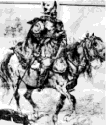
Captain Diego de Villarreal was born in 1601, in San Miguel el Grande (de Allende),
Guanajuato, It is believed that he was the son of Francisco Villarreal,
who was a resident of the town of Saltillo. According to a book Silent Heritage by Richard Santos, the parish priest of
Saltillo once complained to the inquisition about Don Diego whom he
described as riding a horse, wearing silk clothing and jewelry even
though those privileges were denied by law to a descendant of parents
who had been converted from Judiasm to catholicism as adults. My research has not uncovered this document. Only a document from a descendant of a political enemy of the Villarreal family, but this involved accusations about a Villarreal clergyman.
Diego
was recorded as a witness in Nuevo Leon in 1613. In 1625 he was a
Lieutenant in charge of troops and dedicated himself to mining. In a
later declaration he stated that he took the job of Lieutenant when
Governor Zavala took over in 1626. Diego patrolled the frontier out
of Monterrey and Cerralvo. He was later named Captain. He founded the
Hacienda de Minas de la Magdalena en el Real de las Salinas, in 1627,
whereby giving birth to the actual Villa de Abasolo, Nuevo Leon.
He was head of the first town council
of
Cerralvo in 1638. He was elected
Mayor of Cerralvo in 1644. In 1645 he was also named Chief Justice
"del nuevo descubrimiento del Real de Limpia Concepcion y minas de la
Caldera". In 1647 he was accused by Francisco Baez Benavides of
(Entropecer las Labores Mineras) and of mistreating the Indians. He
participated in the war against the Orames (Indians ) which invaded
Coahuila.
Such important positions would indicate that
he was already a man of standing when Zavala arrived. He became one
of the most affluent and powerful men of the Realm of Nuevo Leon,
Just a step below Bernabe de Las Casas (His Father in Law) and Blas
de la Garza. However he was younger than Don Bernabe and had no large
financial backing when he came in, so he came to bloom a little later
than they did. Diego Married Beatriz de Las Casas Navarro, daughter
of Don Bernabe, by these means and coupled with his own considerable
ability he got his backing in 1654. For many years he had holdings in
the Valley of the Salinas, Diego operated a silver mine "for the
benefit of the King and himself." In May of 1654 he made a request
for a grant. The holdings he had previously could have been from the
estate of Don Bernabe, but he must have had some capital of his own
when he came into Nuevo Leon.
Diego purchased from his sister in law
Juliana the mines el puesto de Chipinque he is known as having
founded the town of El
Carmen, Nuevo León. This was
located in the
Valle of Salinas.
He maintained, at his own expense, a force
of men whose job it was to protect his holdings and those of his
neighbors. The men were always ready, with horses saddled and their
gear in place so they could respond quickly. He was always ready to
help others as demonstrated by his support of Maria Cantu and her
orphan children after she was driven out of the Rio Blanco country by
the Indians at the death of her Husband Don Diego de
Hinojosa.
There were other Villarreales in the New
World, but the men mentioned above were probably his ancestors. It is
anybody's guess which of the four it might have been. But these men
were all stable, prosperous settlers, and brothers always had a
better chance of survival and advancement than the lone
individual.
So much for speculation. There is no mention
of any other Villarreal in Nuevo Leon in that first half of the
1600's. As the family became so well represented in numbers in the
region, it becomes interesting to see how that came about. It is my
opinion that his father was Francisco de Villarreal. A list of the
children of Don Diego and Dona Beatriz points the way.
In the Journals of Alonso de Leon the
Leadership of Diego as a Loyal and trusted Subject of the crown , was
many times mentioned. In 1638 Diego Villarreal is mentioned as the
first Procurador General of the town of
Cerralvo, in 1643 Governor Don
Martin de Zavala of the province of Coahuila named Captain Diego de
Villarreal Mayor and War Captain of a mining Outpost which was being
threatened by a neighboring Governor of the province of Viscaya, The
governor of Viscaya is described as the richest and greediest man in
the world. The governor of Viscaya with the influence of the mayor of
Saltillo had been moved by a rumor that in Coahuila the lost mines of
Castano had been found. This quickly fueled the Governors ambition
and love for riches and he immediately appointed Captain Mateo de
Arredondo as Mayor and War Captain for this new outpost , this
outpost was not even in the Jurisdiction of the governor of Viscaya ,
this was why Governor Zavala appointed Captain Villarreal to this
position and gave him orders to arrest captain Arredondo and take
over his position as Mayor and War Captain. Captain Villarreal
carried out his orders and Governor Zavala sent for reinforcements to
back up Villarreal the Governor of Viscaya did the same and in order
to keep the peace he ordered Captain Arredondo released. Both
governors sent their complaints to Mexico City and for four years not
a single ounce of silver was mined from this desolate outpost. This
outpost was the mines of Salinas where Diego settled with his family,
Diego later mined the silver for the King and for himself, it was
from here that the Villarreales would emerge as one of the most
influential and respected families in the Northern frontiers of New
Spain. Diego and his family settled in an area north of Monterrey now
known as Salinas Victoria.
Diego's sons Captain Cristobal and brother
Francisco De Villarreal had first seen the Rio Grande Valley when
they accompanied Alonso De Leon on explorations of the Gulf Coast to
the Nueces River in 1686 to 1690 in search of the settlement of
Robert Cavelier Sieur De La Salle, a Frenchman who had established a
settlement Fort St. Louis near Matagorda Bay in Texas.
 Back
to Table
Back
to Table

THE
JOURNEYS OF CRISTOBAL AND FRANCISCO VILLARREAL
WITH
ALONSO DE LEON INTO TEXAS
IN SEARCH OF THE FRENCH
SETTLEMENT FORT SAINT LOUIS
In the year 1689 the Indians of the north
were raising havoc among the settlements of
Coahulia and Nuevo Leon so both Governors
mustered up their finest and most experienced soldiers in order to
pacify the region. They made two expeditions against the enemy with
much success. And going out on the third one to wind up the
resistance that was offered them, they got word from the other side
of the Rio Grande that at a distance of some one hundred and twenty
miles there was a Frenchman in a large Indian camp and that the
Indians thought very highly of him. With this notice a decision was
made to go with only eighteen men. These men were picked to the
satisfaction of the governor and after six days they reached the
Indian camp that was seventy five miles beyond the Rio Grande . They
held an offensive position and the Governor entered with a General
Mendiondo and a priest Buenaventura Bonal. The rest of his men
remained on horseback. They went into the habitation, notwithstanding
that there were over six hundred Indians in the camp and forty two of
them on guard with arms in their hands.
In the most spacious of the tents, that were
formed out of Buffalo hides, they found the Frenchman and two Indians
were fanning him and others were cleaning his face. The Frenchman
seeing the priest dropped to his knees and kissed the hem of the
Priest's habit. He then made a courtly bow to the Governor and the
General. The Spaniards brought out gifts of clothing knives and
tobacco so that the Frenchman could distribute among the Indians,
which he did. The governor told him to tell the Indians he was going
with the Spaniards. He resisted at first and the Indians did
likewise. Not withstanding, the pressure they got him on a horse, and
hit the trail back to the force, accompanied by many Indians from the
camp. The Indians were discontented about being taken away but in
spite they reached the settlements in Coahuila. When they reached
Coahulia with the prisoner, he was questioned, he stated that there
was a french settlement in the bay of Espritu Santo he said that the
settlement had been there for some fifteen years , that there was a
castle on the far side of the river and a smaller one on this side.
He claimed that the larger on had twenty pieces of artillery and that
the smaller one was protected by muskets, which were of the Flemish
type. He stated that the settlement had four streets and that there
were six companies of soldiers that they had priests and that there
were three vessels that traded between the post and France and that
they had plantings of corn, tobacco, wheat as well as sugarcane and
many cattle. He stated that he was sent to live among the Indians in
order to win their alliance for France and that he was frequently
visited by his comrades. He was questioned quite extensively in
Monterrey and then handed over to the General Mendiondo and sent to
Mexico city for further questioning.

The eighteen men who followed
Governor de Leon across the Rio Grande to get the Frenchman deserve
to be remembered: Besides Don Martin de Mendiondo there were
seventeen more, some of the Nuevo Leon Company and some from the
residents of Coahuila. They are as follows:
Nuevo Leon Company |
Coahuila Company |
Carlos Cantu
Gerinimo Cantu
Juan Cantu
Juan de la Garza
Lorenzo de la Garza
Tomas de la Garza
Alonso de Leon the third
Nicolas Medina
Cristobal Villarreal
Francisco Villarreal |
Joseph Baez
Juan Flores
Antonio Montes de Oca
Diego Ramon
Tomas Sanchez
Joseph Jimenez |
AMONG THESE MEN MANY OF THEIR DESCENDANTS
WOULD COLONIZE THE RIO GRANDE SETTLEMENTS IN TEXAS. THEY ALSO WERE AMONG THE
FIRST EUROPEANS TO MAP AND DOCUMENT THE AREA BETWEEN THE RIO GRANDE
AND THE NUECES RIVERS IN TEXAS AND BEYOND. THEY WERE ALSO RESPONSIBLE FOR NAMING THE
TEXAS RIVERS AS WE KNOW THEM TODAY. ON DE LEONS 5TH EXPEDITION THEY
DELIBERATELY LEFT HORSES AND CATTLE AT EVERY RIVER CROSSING , THUS
STARTING THE HERDS OF WILD CATTLE IN TEXAS AND THE HERDS OF WILD
MUSTANGS THAT WOULD BECOME A WESTERN LEGEND.
Back to
Table

FRANCISCO
AND CRISTOBAL VILLARREAL SONS OF DIEGO
Francisco and Cristobal had a very close
relationship. They rode together into Texas with Alonso de Leon and
were among his picked men. They also owned a large hacienda that they
apparently held in partnership. It is told that the holdings, in
Northwest Nuevo Leon or North east Coahuila, are still referred to or
named The Ranch of Francisco and Cristobal. As Don Francisco married
Ursula de Ysaguirre in 1673 at an early age for a Spanish male and
died so young at thirty five and left a house of small children, it
is likely that Don Cristobal took charge and reared the orphans and
kept the holdings as a joint venture in memory of the brother to whom
he was so close. Naturally his own children and the nephews would
continue to perpetuate the feeling. Thus the lasting name of the
Ranch Francisco and Cristobal, two hundred years afterwards. Note:
the intermixing of the prominent families. Don Diego and Beatriz had
either as in-laws of their children or grandchildren at least
nineteen de la Garzas, ten Trevinos, and five Cantus. These same
families make up the Nuevo Leon Company.

THE 2ND JOURNEY OF CAPTAIN
CRISTOBAL VILLARREAL IN 1689
WITH GOVERNOR DE LEON INTO
TEXAS
TO
FIND THE FRENCH SETTLEMENT
AND
THEIR EXPLORATIONS OF THE BAY
OF ESPRITU SANTO
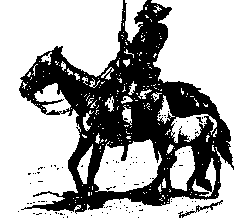
"THE FIRST OF THE RACE" BY FREDRIC
REMINGTON
This Journey was one of the most significant
Journeys into Texas, it not only found the French settlement but it
was on this expedition that most of the Eastern Texas Coastline was
mapped, explored and the journey in which the Texas rivers were
named. From the information received from the French prisoner and
from eyewitness reports, the Spanish government resolved on another
expedition. Alonso de Leon was chosen to head this expedition with
100 paid hand picked men. In the party were fifty soldiers of five
presidios of New Vizcaya and the other fifty were from the New Realm
of Leon. His excellency to pay for this expedition, issued eighty
loads of flour, steers and other things from the Royal Storehouses.
Along with these soldiers was the French prisoner, twelve herders,
thirteen servants, seven hundred and twenty animals, horses, mules
steers and three loads of clothes and other things to give the
Indians. Nearly a month later the french settlement was reached it
was found to be abandoned and the remains of Men women and children
were found strewn about. The conclusion was that the settlement had
been attacked by the very Indians whom they were friends with. The
bones were gathered up and buried with a mass sung. The settlement
consisted of a small fort made of lumber and six houses. They had
been plundered of the furnishings and over two hundred books in the
french language had been torn up. The Indians had not only destroyed
the homes and furnishings but had destroyed all the arms found
inside, including more than 200 stands of arcabuses. These had been
broken from the barrel over artillery pieces. The settlement was in a
location to defend against any kind of enemy. Close to the
settlements there was a cultivated area where stalks of maize had
been planted and were still standing. After two days at the
settlement De Leon proceeded to explore the bay and the surrounding
area. They explored some twenty four miles of coast line and found
the remains of numerous shipwrecks as well as seeing a lost vessel in
the bay whose hull was still visible from shore. They found canoes
and also discovered the great River which they named the San Marcos.
It was learned that four Frenchmen whom had been hunting while the
attack took place had gone to live further north with the Tejas
Indians, word was sent to them that the Spaniards were at the
settlements and to come back with the Europeans, and they would be
allowed to return safely. After many days wait the Frenchmen returned
and joined the Spanish explorers on their return to
civilization.
After months in the saddle, riding the half
wild horses that made up the horse herds, and wearing coats of chain
mail day after day, sleeping out without any kind of protection,
eating the food of the camp, and facing strange tribes of Indians,
stampede of horses, crossing large rivers, and putting up with the
many discomforts of the camp, the Captain Cristobal returned to his
ranch with many stories and adventures which you and I can only read
about in the History books of Northern Mexico. Very little
recognition of these men was ever given in Texas History books yet
their spirit was what made Texas ready for later generations to
continue future explorations.
 Back
to Table
Back
to Table

1747
THE TEXAS COLONIZATION
PERIOD
ITS EARLY SETTLERS AND THEIR
HISTORY
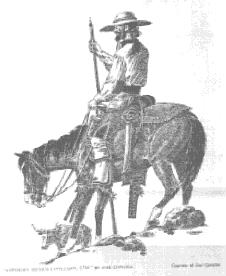
"NORTHERN MEXICO
CATTLEMAN
1740"
BY JOSE
CISNEROS
THE SOUTH
TEXAS SETTLEMENTS
The Villarreales were recruited by Spanish
colonizer and Governor of the province of Nuevo Santander Jose De
Escandon in 1745, to become first settlers of the new Colony, since
they were already adjusted to the climate and knew the terrain of
this region, having lived in the Monterrey, and Saltillo area
some 100 years before.
The history of the colonization of South
Texas and its original colonists is a story that is very different
than that of the rest of the state since the area south of
the Nueces River to the Rio Grande River was never a part of the
Republic of Texas. This area was disputed territory between the Texas
and Mexican government, and the local settlers were always loyal to
Mexico.The history of this area began long before Mexico became
Mexico. It was in 1747 to 1749 that colonization began. Our ancestors
were part of what was the first great land rush that took place in
the present day United States. For many years the Spaniards had
claimed these vast expanses of cactus and mesquite thickets where
many Indian tribes roamed as well as herds of cattle, horses and a
very large population of wild animals.
Of the 23 settlements established by
Governor Escandon, Reynosa was founded on March 14, 1745 with forty
Spanish families from Cerralvo, Cadereyta, El Pilon, Sabinas
Pesqueria Grande, and Monterrey, Nuevo Leon. The Villarreal families
settled in both Camargo and Reynosa. This family was among the first
to settle on the North Bank of the Rio Grande River along with the
Garza, Coy, Solis, Falcon, Gonzalez, and Perez families, all of whom
had been given permission many years before the establishment of
ranches. Their improvements had been made with the understanding that
when the time came for property division, their houses, pastures and
fields would be deeded over to them.
 Back
to Table
Back
to Table



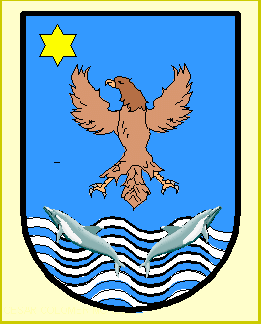
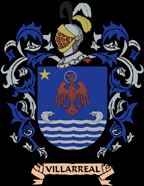 Castilla
Castilla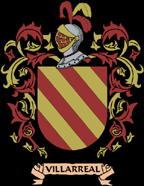
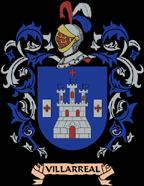 Vizcaya
Vizcaya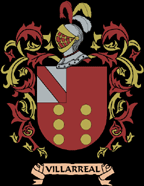
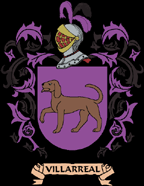
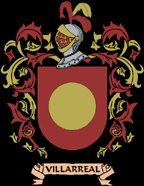
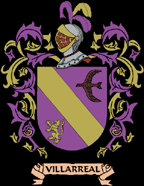
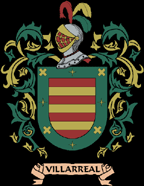
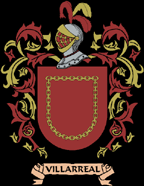
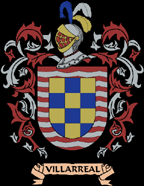

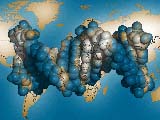



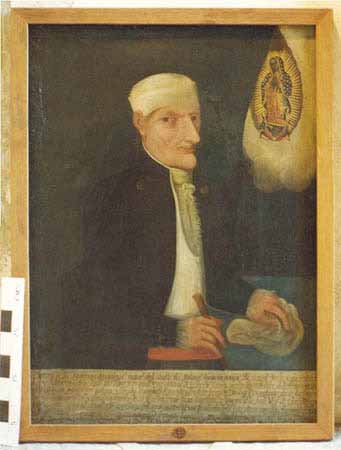



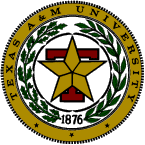 I
WENT TO TEXAS A&M UNIVERSITY
I
WENT TO TEXAS A&M UNIVERSITY




